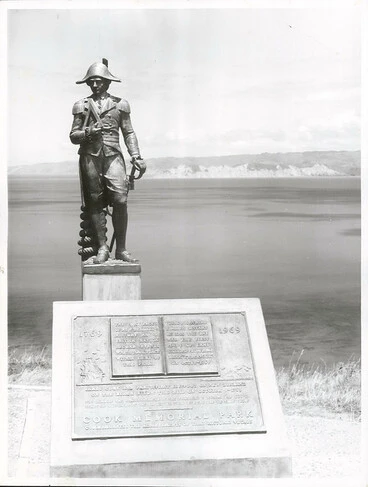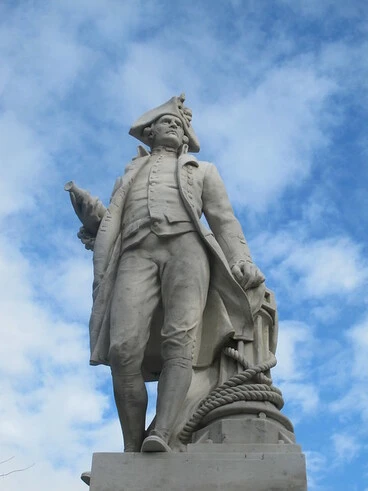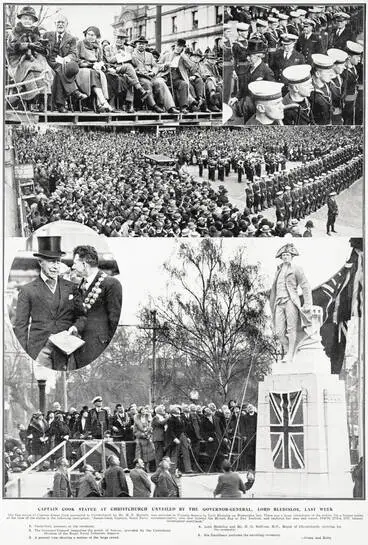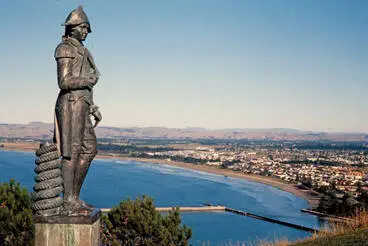The Crook Cook statue
A DigitalNZ Story by DigitalNZ
Parts of the Captain Cook statue on Gisborne’s Tītīrangi Hill were painted red in 2016. In October 2018, the Gisborne District Council decided to remove the statue.
These resources and text relate to the “Crook Cook” statue on Kaiti Hill in Gisborne/Tūranga-nui-a-Kiwa and also the wider context of voyages of discovery and colonialism. They have been sourced and collated from DigitalNZ and other websites.
Background
In 1969 a statue of Cook was installed on Kaiti hill (Gisborne). It looked out over Poverty Bay and towards Young Nick’s Head (both named by Cook). Kaiti Hill is the maunga of Ngati Oneone, the local iwi.
Over time the statue became known as the 'Crook Cook' statue because experts claimed it didn’t realistically depict Captain Cook. For example, the statue’s uniform is actually that of an Italian admiral not a Royal Navy commander, which Captain Cook was.
For 50 years debate has raged around the Crook Cook statue. Should it be left, removed or a new statue erected?
Adding to the statue’s authenticity issue are more recent discussions round colonialism. There is a growing desire to tell a more balanced and truthful story about the first and subsequent encounters between European and indigenous peoples.
Context
“…there are three stories at stake. The first is the story of the encounter between Cook and Māori in 1769. The second is how that story has been told by New Zealanders over the past 250 years. The third is how that story could be told in the future.” Historian Rowan Light
A red face and underpants
In 2016 the ‘Crook Cook’ statue in Gisborne was vandalised with red paint and Cook received a red face and red underpants. Why?
The Endeavour’s famous scientific expedition has not been viewed positively by everyone, especially indigenous Pacific peoples — like Hawaiians, Māori, and Aborigines.
Cook’s arrival and contact with these peoples was a precursor to colonisation, a process defined as “settling among and establishing control over the indigenous people of an area.” As white settlement increased so did the subjugation and dispossession of indigenous cultures through disease, slavery, warfare and land seizures.
For example, Cook’s first landing in Poverty Bay may have had a genuine scientific intent but it also led to the deaths of around 9 local Māori over 3 days.
Some people view European-centric statues like the "Crook Cook" as constant reminders of colonialism's disastrous impact on the original inhabitants. Defacing them is both a form of protest and a questioning of why we commemorate or honour just one perspective of our collective past.
Today some local Ngati Oneone elders wish to see the removal or replacement of the ‘Crook Cook’ statue. A preferred option is a statue commemorating their tipuna Rakaiatane, a local rangitira at the time of Captain Cook’s arrival.
This would convey a more balanced and inclusive story about Captain Cook's first encounter with Māori in 1769.
Fertile questions
- What does the red paint mean?
- Ki ōu whakaaro, he aha i pēneitia ai te whakapakoko a Kāpene Kuki?
- How do we decide what to commemorate?
- How do we decide who to commemorate?
- Where is the past in the present?
- He aha te ngako o te whakatauki, ‘titiro whakamuri, kia anga whakamua’?
- What is art and its function in our lives?
- What is your question?
Quick facts
- In 2002 councillor Craig Bauld wrote a letter to Gisborne District Council calling for the statue’s removal. He said in part, “I am proposing we stop mucking about, I recommend to council right now that the (Cook) statue goes, end of story . . . Along with the removal goes the review of wording on the plaque — it gives the strong impression that the history of Gisborne began with the arrival of Cook.”
- Cook was killed at Kealakekua Bay, Hawaii on February 14, 1779 — but not before he and his crew killed around 30 Hawaiians, including a Hawaiian chief, with muskets and cannons.
- Ngāti Oneone has called for the 'Crook Cook' statue on top of Gisborne's Kaiti Hill to be replaced with that of Māori chief Rakaiatane.
- NASA named their final space shuttle Endeavour after the ship Captain Cook commanded on his first voyage around the world.
- Cook’s attempts at understanding the indigenous peoples he met can be seen in his use of local names for places where he could find them.
- Two of New Zealand’s most significant landmarks are named after Captain Cook: Cook Strait which separates the North and South Islands and our highest mountain Aoraki/Mt Cook.
Statues of Captain Cook repeatedly vandalised in Gisborne
Radio New Zealand
Captain Cook statue
Christchurch City Libraries
Other resources
Awapuni School— Captain Cook memorials in Gisborne.
Captain Cook is a contested national symbol— Cook had a major influence on the world during his lifetime.
Captain Cook statue targeted by vandals— there's a controversial statue at the Cook Plaza on Kaiti Hill.
Captain Cook 'First Encounter' celebrations — the first encounters between Europeans and tangata whenua was marred by misunderstanding.
Councillors vote to remove 1969 "Crook Cook" statue— the Captain Cook statue will soon be removed from Titirangi/Kaiti Hill.
"Crook Cook" at Cook’s Plaza on Kaiti Hill Gisborne— a statue of a Maori chief should be on top of Kaiti Hill, says Ngati Oneone.
Defying Empire — James Cook artwork.
Paint poured over Captain Cook — there have been incidents involving the defacement of controversial statues or calls to pull them down.
Statues of colonial white guys— why do we have statues of dead white colonial men?
Unveiling the history of the 'Crook Cook'— the fascinating history of a controversial statue.
Captain Cook statue relocation — Ngā whakaaro o te hau kainga e pā ana ki te whakaneke o te whakapakoko o Kāpene Kuki. Nā Te Kuru o te Marama Dewes te pūrongo i tuhi.
Kāpene Kuki — He pūrongo huatau e pā ana ki a Kāpene Kuki.
Kāpene Kuki — He pito kōrero e whakamarama ana i tā Sam Neill whakaaro e pā ana ki a Kāpene Kuki. Nā Diana Wichtel i tuhi.
Ngā kōrero a ipurangi o Aotearoa - Kāpene Kuki — Kei tēnei pae tukutuku tētahi o tā Kāpene Kuki kōrero haurongo.
Ngā kōrero o Kāpene Kuki — He pito kōrero tahito mai i te hautaka Pipiwharauroa
The Captain Cook Society — He pae tukutuku hei kohi kōrero whānui e pā ana ki a Kāpene Kuki
Looking west from the roof of the Captain Cook Brewery along....
Auckland Libraries
STATUE OF CAPTAIN COOK. (Northern Advocate, 08 July 1914)
National Library of New Zealand
QUEEN VICTORIA STATUE DEFACED. (Colonist, 16 November 1908)
National Library of New Zealand
STATUES FOR THE OCTAGON. (Otago Daily Times, 06 February 1884)
National Library of New Zealand
A STATUE DEFACED. (Ashburton Guardian, 10 June 1914)
National Library of New Zealand
ADDITIONAL QUESTION
- Are there benefits to learning about other people’s history?






